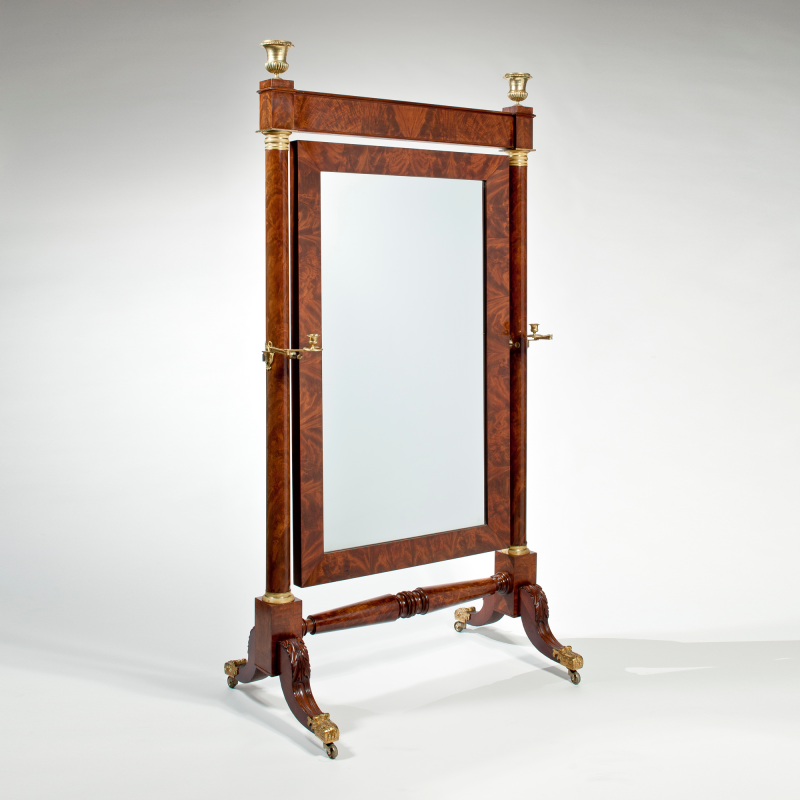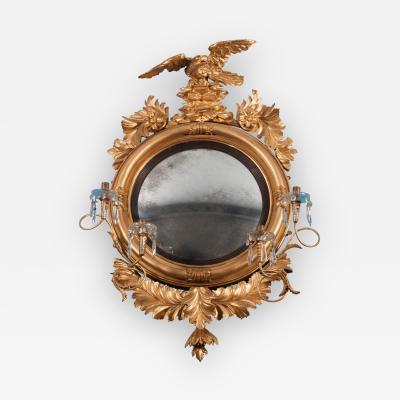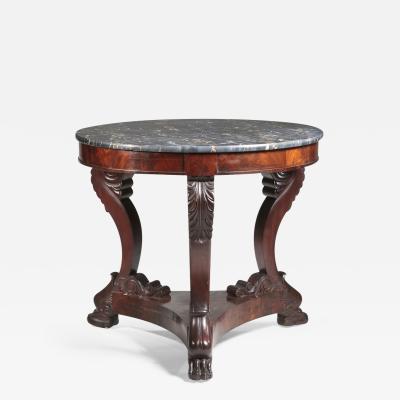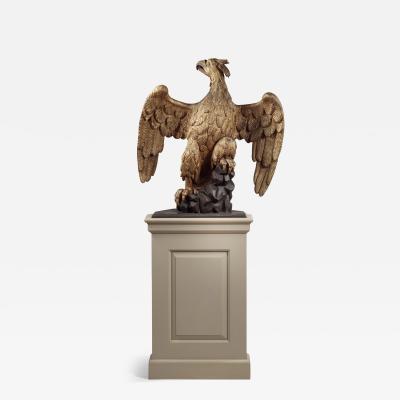Important Bronze-Mounted Mahogany Cheval Dressing Mirror, c. 1820
-
Description
Attributed to Duncan Phyfe (1770-1854)
A standing frame comprised of veneered columns with gilt bronze capitals and bases supporting a molded frieze with gilt-bronze urns at each end, on a trestle base with a turned stretcher with medial ring turnings and saber legs having acanthus leaf carving at the knees and elaborate brass toe caps, holding a molded mirror frame by a pair of brass pins so that the mirror can swing. Brass candle arms are attached to the vertical columns with gilt-bronze appliqués.
The concept of a free standing, “cheval” or “horse” mirror was first published in 1793 by Thomas Sheraton in The Cabinet-Maker and Upholsterer’s Drawing Book and reintroduced in his Cabinet Dictionary in London in 1803. The term derives from the position of the four legs, two at each end of the trestle base. It is a form that was also published by French designers at about the same time. Pierre de la Mésangère shows cheval mirrors as early as 1796 in his periodic Collection de meubles et objets de goût and, indeed, this example seems to be related to Mésangère’s plate 459 published in 1818. Percier and Fontaine’s design for free standing mirrors appear as early as 1801. These publications were followed by a host of English pattern books, each devoting attention to the form including those of Thomas Hope, George Smith, Richard Brown and Peter and Michelangelo Nicholson.
American classical high style examples are quite rare. Indeed, few of this quality are known and there are only two closely related examples; one is in the collection of the Maryland Historical Society and the other in the collection of Richard Hampton Jenrette at "Roper House" in Charleston, S.C. Although Charles Honoré Lannuier, the great French émigré cabinetmaker in New York, used a drawing of a cheval glass on his furniture label and a very closely related mirror to the present example was owned by James Bosley, a client of Lannuier, no cheval mirror by him is known, nor is his work known to include any trestle base furniture. Conversely, Phyfe is known to have made many tables with closely related trestle-bases about 1820 including two card tables that bear his label. The turnings in the middle of the stretcher are very distinctive and are very closely related to those on the stretcher of a bronze-mounted rosewood card table bearing Phyfe's label illustrated in Peter M. Kenny and Michael K. Brown's Duncan Phyfe: Cabinetmaker in New York (New York, The Metropolitan Museum of Art, 2011), p. 200-201, pl. 26. The style of the turnings appears repeatedly in Phyfe's furniture and is virtually a signature of the firm. -
More Information
Origin: United States, New York Period: 19th Century Materials: Mahogany Veneer, Backboard: Tulip Poplar. Condition: Excellent. The mirror plate appears to be original, wood re-finished with shellac in the manner of the period, brass candle-arms may be re-gilded or replacements. Creation Date: 1820 Styles / Movements: Classical Dealer Reference #: M-002101 Incollect Reference #: 104943 -
Dimensions
W. 41 in; H. 74.25 in; D. 24 in; W. 104.14 cm; H. 188.6 cm; D. 60.96 cm;
Message from Seller:
Welcome to Carswell Rush Berlin Antiques, a premier New York City-based dealer specializing in American antique furniture and decorative accessories from the Classical period (1800-1840). For inquiries, please contact us at 646.645.0404 or email carswellberlin@msn.com.
Sold































